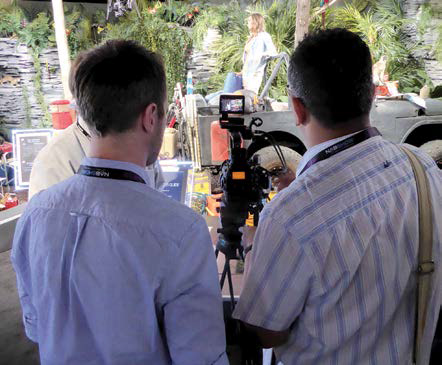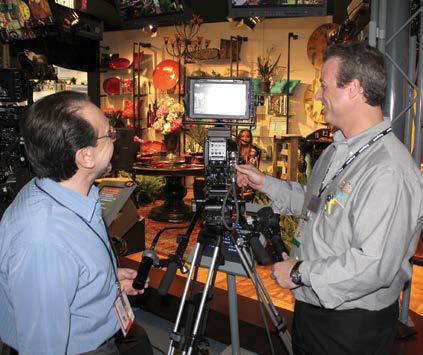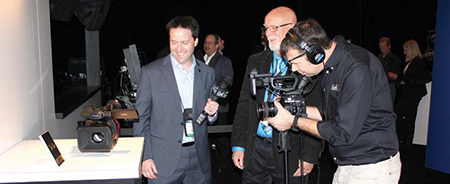NAB 2015 Camera Review
The big news in cameras from the NAB Show was the introduction of three-sensor, 2/3-inch 4K models, which can use the B4-mount lenses that are ubiquitous in large venue live sports and entertainment production. There were also a number of advances in single-imager large-sensor 4K cameras.
STUDIO AND FIELD PRODUCTION CAMERAS
AJA announced a free, field-upgradeable 1.2 version of its software for the CION 4K/UltraHD and 2K/HD professional production cameras. The upgrade provides image improvements, new features and other enhancements. The company also announced its “Try CION” program, a promotion for placing 100 CION cameras with qualified shooters.

Mark Wilson (L) and Danny Dawson, both from Alias Hire, check out the Canon C300 Mark II camera with a Canon CineServo 17-120 Super35 lens.ARRI unveiled ALEXA Mini, a five-pound miniature version of ALEXA. The Mini records ProRes 4K to CFast 2.0 cards with ARRI RAW support soon to be added. It also features a new optical eyepiece. Transvideo also now offers a five-inch monitor—the StarlightHD5- ARRI—that provides touchscreen control of the ARRI AMIRA and ALEXA Mini cameras.
BLACKMAGIC DESIGN introduced URSA Mini, a small form-factor model of its URSA 4K cameras, available in 4K or new 4.6K sensor models with either EF or PL mounts. The 4.6K capability is also available on Blackmagic’s other URSA cameras, and an upgrade allows it to be installed in existing URSAs. Also new is the Micro Studio Camera 4K, which can be used for HD and Ultra HD production, operating up to 2160p30 in Ultra HD or up to 1080p60 in HD. It features a built-in color corrector, talkback, tally indicator, PTZ control output, B4 lens control output, and a flexible MFT lens mount. The similar-sized Blackmagic Micro Cinema Camera is a miniaturized Super 16mm professional digital film camera with an expansion port that lets users use PWM and S.Bus model airplane remote controls to operate the camera wirelessly for capturing action anywhere.
CANON unveiled their C300 Mark II camera with a new sensor and processing system providing 15 stops of latitude. It features an interchangeable EF/PL lens mounting system, an on-board mic, as well as XLRs or external audio sources. Also new was the 4K-capable XC10 camcorder which sports an 8.9 to 89 mm lens that provides a 35mm video mode equivalent to focal lengths between 27.3 and 73 mm.
GRASS VALLEY, which unleashed the 2/3-inch three-sensor 4K B4-mount box camera race last year, returned this year with the fully functional LDX 86 4K model that delivers 3,840 x 2,160-pixel images from a trio of super-sampled 2K sensors. The new camera simultaneously delivers live standard-frame-rate 4K video and 6x slow-motion HD video.

Stephen Aposto of the Buffalo Bills gets the lowdown on the Ikegami HDK-65C camera from Chris Ahern.HITACHI, which earlier introduced a 2/3-inch, 2K super-sampled four-sensor 4K camera, this year showed a prototype camera using three 2/3-inch 4K sensors. Both cameras use B4-mount lenses. The new UHD4000 uses four 2K chips: one red sensor, one blue and two greens, with the second green chip offset onehalf pixel vertically and horizontally.
IKEGAMI showed a handheld camera system that’s a fourth-generation 8K camera using a single 33 million pixel Super 35 CMOS sensor. It’s one-tenth the size of Ikegami’s first-generation 8K camera. The company also premiered a 2/3-inch CMOS 4k camera and a new 4k base station.
JVCKENWOOD introduced a trio of 4K memory card cameras. At the top of the line was the GY-LS300, with a MFT lens mount allowing use of a wide variety of lenses, and includes VSM (variable scan mapping) for matching lenses and sensor scan size. Also featured were the GY-HM200 Professional 4K camcorder with live streaming capability, and the GY-HM170 compact professional 4K camcorder.
PANASONIC introduced its high-resolution AK-HC5000 studio camera, which provides high-speed output at up to 200 fps and incorporates new 2/3-inch 2.2 megapixel three-CMOS sensors for 1080/60p native capture. Also new were the AJ-PX380 1/3-inch AVC-ULTRA shoulder-mount camcorder with networking capabilities and dual-codec recording, and the AG-DVX200 4K handheld camera with a 13x image-stabilized lens.
RED DIGITAL CINEMA took the wraps off WEAPON, the newest member of the 6K DRAGON family. It provides new color capabilities with the dynamic range of the 19 megapixel RED DRAGON sensor and also features simultaneous onboard REDCODE RAW and Apple ProRes recording, as well as 1D and 3D LUTs for precise color matching.
SONY introduced its HDC-4300 2/3-inch 4K three-sensor camera, which uses the B4-mount lenses necessary for sports and large event broadcasting. The camera features up to 8x “Super Slow Motion” in regular HD and 4K, with switchable flexibility. Also featured was the PXW-X320 XDCAM shoulder-mount camcorder with three 1/2- inch sensors, support for MPEG/XAVC, and wireless streaming and file transfer.
SPECIALTY CAMERAS
FOR-A showed the latest version of its FTONE-S 4K variable frame rate camera, now with a smaller and lighter form factor and with the ability to separate the camera head from the body for use in challenging locations. It can capture action at up to 360 fps.

Bernie Mitchell details features of Panasonic’s AG-DVX200 2/3-inch single chip 4K camera to Abel-Cine’s Andy Shipsides and Iam McCausland.GOPRO’s big news was the HeroCast system, which wirelessly transmits the full HD output of the company’s Hero4 and Hero3+ Black cameras, allowing GoPros to be integrated into live sports coverage.
I-MOVIX showcased its X10 UHD RF highspeed camera system, which extends operational flexibility of the X10 high-speed camera technology by supporting wireless shooting in HD close-to-the-action productions. The camera operates in a USD (ultraslow motion) mode for use in HD sports coverage, delivering instant replays of up to 3,000 fps in 720p, or up to 2,000 fps in 1080i.
VISION RESEARCH introduced a cluster of upgrades to its Phantom Flex4K digital cinema camera, which can record at up to 1,000 frames-per-second with full 4K resolution. These upgrades include Apple ProRes 422 HQ as an alternative to the camera’s native raw workflow, as well as audio recording for sync-sound and higher frame rates, and a boost in storage capacity with up to 128 GB of RAM.
Get the TV Tech Newsletter
The professional video industry's #1 source for news, trends and product and tech information. Sign up below.
